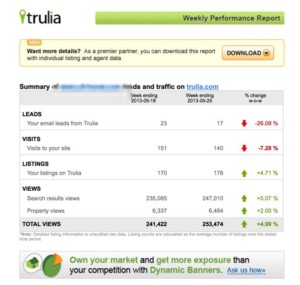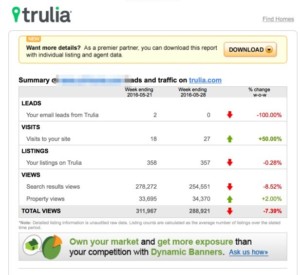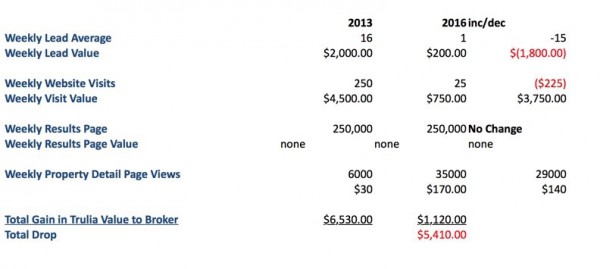

WAV Group provides brokers with consulting on online marketing. One of our services includes benchmarking the effectiveness of listing syndication strategies. We have been tracking the performance of a real estate broker’s listings dating back to 2006 by publishing channel. As these reports show, Trulia effectiveness has decreased to a remarkable volume of no leads per week on 367 listings. The same report in 2013 showed between 12 and 25 leads per month.
It begs the question “If a third party consumer website is not delivering value, should a broker continue to syndicate?”
One thing is for sure, we can thank Trulia from helping real estate broker and agents get away from newspaper print display advertising. Trulia provides a vehicle where by a seller can be assured to reach a reasonable pool of prospective buyers.
Newspaper effectiveness died in 2000 when brokers were routinely paying hundreds per listing in print advertising per month. Trulia not only allowed brokers to divest in print advertising, but they pay them in the return of leads, website visits, consumer online property walkthroughs, and so many other intangible ways.
Consume this information carefully. If you are a broker, pull your Trulia reports and observe your benchmarking changes. Depending on your market, these numbers could vary greatly. I have seen far better performance than this and far worse. I chose this because it is a middle case for us. Think of this as nothing more an illustration of the analysis that you should do to measure the effectiveness of your online marketing and listing syndication strategy.
Site Visits from Trulia to Broker Website Decline
There are some astounding observations from the comparison of 2013 to 2016. Site visits to broker sites dropped from 140 or 150 in 2013 down to 16-27 in 2016. Here is another way to look at it. When brokers purchase click traffic on this type of website, they average something like $30 cost per click. In 2013, the value of putting your listings on Trulia included the number of clicks multiplied by the market value of a click – ($30*150=) $4500 in online advertising value per week. Today Trulia has dropped to delivering about 25 clicks per week ($30*25) or $750 dollars in online advertising value. This particular broker gets 5500 unique visitors a week to their broker site, so the drop of 25 clicks would not be noticed.
Lead Volume Drops from 20 Per week to 0
Lead values are very different to calculate. The value of a lead is calculated to the price value of the conversion contribution to revenue. If we use ballpark range of $100 cost per lead, then in 2013 and average of 20 leads a week was worth $2000 per week in online advertising. In 2016, that has dropped to $200 per week in online advertising value.
Trulia Traffic to search results stays the same.
It is fascinating to look the traffic numbers in this report. Total traffic to Trulia has remained constant at roughly 250,000 views per week from 2013 to 2016. That is flat traffic. But I think you could argue that users are searching better on Trulia today than in 2013. Consumers are able to use search to return refined results far faster today then ever before. Think about the “around me” feature on Mobile. It returns some highly accurate search results vs a standard form based search. Better searches means fewer of them – yet Trulia has kept the search number up – presumably with higher overall traffic (Trulia does not provide brokers with share of voice data in these reports.)
Trulia Property Page Views Skyrockets
Property page views, or what you would consider to be CPI or cost per impression is way up. This measures engagement with the listing. A consumer is looking at a property detail page, but not clicked trough to the broker website or inquired about a property. I refer to this as a highly motivated and engaged consumer visitor. In 2013, the numbers were pretty low, around 6000 page views a week. Trulia has caused that number to skyrocket up to more than 34000 listing detail pages in 2016.
This is clearly Trulia’s greatest achievement over the past through years. Given that high quality impressions purchased online is somewhere between $2 cpm and $5 cpm, this impression traffic is valued at $170 per week. Trulia and other sites have long maintained that they serve the consumer at the top of the transaction funnel. As an FYI, This broker gets 170,000 property detail page views per week on their website.
Trulia delivers less activity on twice as many listings
Check out how this broker has grown their business from 2013 to 2016. Their listing count on Trulia blasted from about 175 listings to 360. Leads per listing have dropped to a prorated number of 4 per month on 360 listings. Frankly, Trulia had no leads last week on 360 listings. That is Zero performance.
Here is a deal summary for the broker
Trulia’s Value to Broker
Trulia continues to add value for this broker. There is easily a return of $1120 in weekly online advertising value – about $4500 per month. This broker carries about 360 listings. In effect, the Trulia value to the broker is about $12.50 per listing per month. This is down from $38 dollars in broker value per listing on Trulia back in 2013.
In this artificial calculus of relative and estimated value of online marketing, Trulia is still providing about $12.50 in value to the broker who syndicates to their website. It’s a convoluted way of doing the math, but it’s the best method of comparing Trulia to other advertising that you would otherwise need to pay something for. Today, on nearly every Key Performance Index of the Trulia reports, this broker is getting far less value than they did three years ago.
What happens if a broker does not syndicate to Trulia?
From our assessment, the broker would be forgoing at least $12.50 a month per listing. However, some brokers consider the opportunity costs, which changes the value.
Opportunity Costs
For every broker who has turned off listing syndication and removed 20% of the listings from Trulia, their broker website performance skyrockets, often doubling or quadrupling (publically, Edina Realty, Shorewest Realty and others have confirmed this). Unfortunately, this only works for brokers with more than 1 in 5 listings in a given area (20% market share of listings). They create a vacuum because consumers recognize that inventory is missing. Only big droughts of listings on third party portals shake the consumer’s confidence of those sites.
When brokers with less than 20% of the listing inventory pull listings off Trulia, the consumer melts away to other brokers advertising on Trulia. Those listings are not lost, nor are they found.
Change is definitely happening on Trulia.com. It is still working, but is not the hottest performing darling of online marketing anymore.
Begging the question
I passed this article around to a number of CIOs and CTOs for feedback. These are people who are in the syndication business, in the brokerage business, and that operate portals. I also touched base with people at ComScore and Hitwise. The summation of feedback that I got was scary.
There is a difference between machine traffic online and human traffic. In many cases, it is hard to determine which is which because a lot of data scrapers and “Search Engine Bots” tend to disguise themselves. This pretty much explains why Zillow Group will not allow tracking tools like ListTrac or Listhub on their sites.
If you will recall, another top 5 portal’s traffic fell off dramatically a few years ago when they installed detection and blocking software to stop data scrapers. Their key performance goals are data accuracy, and high quality leads – not traffic volume.
Broker CTOs and CIOs were not surprised. Their keynote expression is that online syndication has been dropping in effectiveness and prices surged up about 20% this year. They are getting far less for their ever-increasing expenses.
The overwhelming reality is that as long as sellers expect to see their listings on these sites, brokers and agents will continue to send them there. Just like newspaper advertising – it does not really matter if it works; it only matters if the seller is satisfied. The majority of buyers come from other agents who find listings in the MLS. Not from portals. Heck, sign calls from a single listing typically generate 5 leads every weekend.





